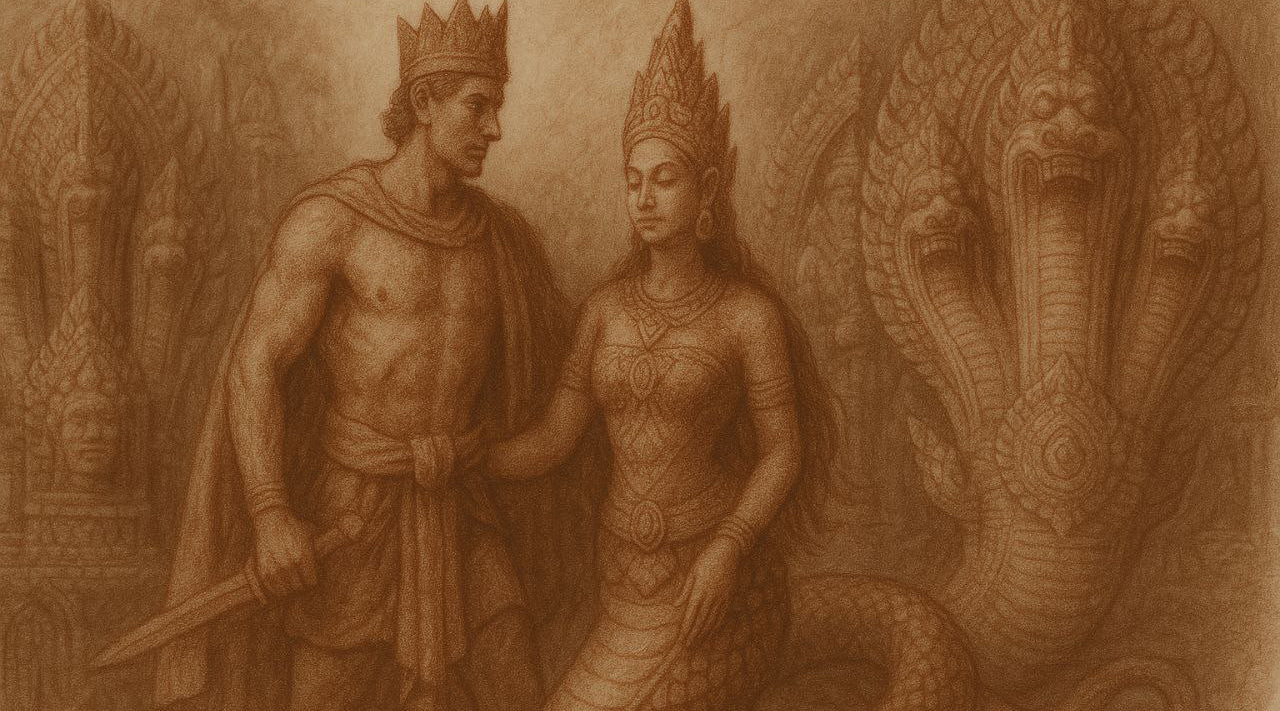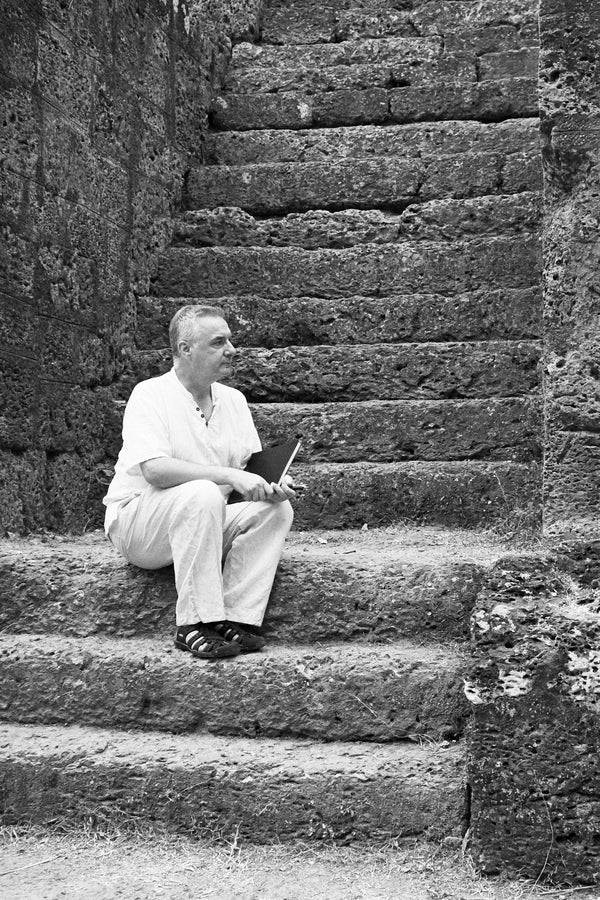Complimentary worldwide shipping on orders over $400 · No import tariffs for most countries
Complimentary worldwide shipping on orders over $400 · No import tariffs for most countries

The Legend of Neang Neak and Preah Thong: The Birth of the Khmer Kingdom
4 min read
The Legend of Neang Neak and Preah Thong
—a poem by Lucas Varro
In the long-forgotten depths of time,
Before the rivers etched their paths,
And the sun whispered its golden rays
Upon the earth's quiet breath,
A tale was woven, ancient and bold—
The story of love, power, and the serpent's gaze.
Neang Neak, a goddess of the waters,
A creature of silk and scales,
Danced beneath the moon’s soft gaze,
Her form both ethereal and eternal,
The essence of the mighty Mekong's flow,
Her heart as deep as the river’s shadow.
Preah Thong, a prince from distant lands,
A warrior with dreams stitched to the sky,
His kingdom was but a fleeting shadow,
His heart restless, seeking the divine.
Drawn by whispers on the wind,
He came to the river’s edge,
Where Neang Neak rose from the depths,
Her beauty a reflection of the stars’ own light.
They met, and in that instant,
The world held its breath.
Her eyes—emerald depths of wisdom,
Her voice—a soft murmur of the tide.
He, too, was changed in that moment,
A spark of fate igniting in his soul.
They spoke not with words,
But with a language older than the earth—
The language of the heart,
Of destiny carved in stone.
Their love, a sacred promise,
Bound them to each other
And to the land they would create.
From their union, a kingdom rose,
Beneath the vast, unbroken sky,
Where the serpent and the royal blood
Merged in an eternal embrace.
The child they bore,
A symbol of their love,
Would rule the land—
A king with the wisdom of the waters,
And the strength of a serpent’s coil.
Thus, the Khmer kingdom was born,
In the hearts of river and stone.
A legacy of serpents' grace,
And royal blood intertwined.

The Legend of Neang Neak and Preah Thong, Study in Chalk.
2025 by Lucas Varro
The Serpent Motif and the Khmer Lineage
The serpent, sacred and revered,
Stands eternal in the heart of Angkor.
Its coils wrap around the very essence of the Khmer people,
A symbol of both protection and power.
For Neang Neak and Preah Thong's child,
The first Khmer king, was born of this sacred union—
A lineage bound to the serpent’s strength,
And to the river's eternal flow.
In Angkor’s temples, the serpent rises—
Sculpted in stone, poised in elegance,
Its undulating form a reminder
Of the ancient waters from which the kingdom sprang.
Each coil, each scale,
A symbol of protection,
A bridge between heaven and earth,
A guardian of the royal bloodline.
The Khmer kings, descendants of the serpent,
Wore this legacy as a crown,
Their authority not just of flesh and blood,
But of the sacred forces that shaped the earth,
Of water, sky, and eternal serpentine grace.
And so, through the stone temples of Angkor,
The myth of Neang Neak and Preah Thong
Lives on—
A testament to the power of love,
The strength of a serpent,
And the eternal bond between the earth and the sky.
The Legend Lives On
The legend of Neang Neak and Preah Thong lies at the heart of Khmer cultural identity, and it explains two of the most iconic and enduring symbols of the Khmer world: the serpent motif in Angkor temples and the divine origin of Khmer royal lineage.
The Serpent Motif in Angkor Temples
In the myth, Neang Neak is a serpent princess—often understood as the daughter of a Nāga king, a powerful water serpent deity. When she marries Preah Thong, a foreign prince, her father performs a miraculous act: he drinks up the ocean, revealing the land where the new kingdom—the Khmer realm—will be built.
This act symbolises the Nāga's role as both creator and guardian of the land. From this mythic origin, the Nāga becomes a sacred figure in Khmer iconography, appearing throughout the temples of Angkor as:
- Multi-headed serpents lining causeways and balustrades (especially at Angkor Wat),
- Guardians of thresholds, often seen at temple entrances,
- Cosmic symbols, representing the churning of the ocean of milk—another foundational myth linked to kingship and the divine order.
The serpent's form, with its fluid grace and coiled energy, is associated with fertility, protection, water, and rebirth—all vital in a culture shaped by the rhythms of the monsoon and the Mekong.
Khmer Royal Lineage
The marriage between Neang Neak and Preah Thong is more than a romantic union—it is a cosmic alliance between the earth's indigenous spirit (Nāga) and a divine or foreign power (the prince). From their union is born the first Khmer king, making all Khmer rulers the descendants of the Nāga.
This myth confers a divine, supernatural legitimacy to Khmer kingship. It tells the people that their monarchs are not merely rulers by blood or conquest, but by sacred inheritance. The king is thus both:
- A human sovereign, who maintains law, order, and prosperity, and
- A spiritual bridge between the world of men and the realm of divine and ancestral powers.
To this day, traditional Khmer wedding ceremonies echo this legend: the groom walks to the bride’s home, reenacting Preah Thong’s journey to Neang Neak, symbolising the joining of two worlds—foreign and native, male and female, sky and earth.
In Summary
The serpent motif in Angkor’s temples is not mere decoration—it is a mythic signature carved in stone. It tells the story of Cambodia’s birth, of a land raised from the sea by a serpent king, and of a royal bloodline sanctified by divine union. Through this legend, every temple becomes a living poem, every stone a whisper of the ancient pact between serpent and king.
Guardians of the Threshold
Photographs from the Spirit of Angkor series by Lucas Varro
In the sacred architecture of Angkor, the naga is not mere ornament—it is guardian, threshold, and mythic bridge between realms. Carved into sandstone with coiled grace and ancient purpose, these serpents line the processional ways of the temples, their many heads flaring like lotus crowns, their bodies undulating across balustrades as if forever in motion.
Rooted in both Hindu and Buddhist cosmology, the naga once carried gods through the waters of creation and now stands sentinel at every sacred crossing. At Angkor, they mark the border between the human and the divine—protectors of silence, watchers of the unseen, timeless presences that hold the edge of light.
In this meditative collection from the Spirit of Angkor series, Lucas Varro turns his analogue cameras toward these sculpted serpents, capturing the mystery they still embody. Using large and medium format black-and-white film, each image is shaped by long exposure, chiaroscuro, and hand-toning—revealing not only the naga’s form, but its enduring stillness. A glint of dawn on weathered scales. A watchful gaze at the gate of stone.
Printed in limited editions on museum-grade Hahnemühle Bamboo paper, each photograph is accompanied by a Collector’s Print Package including poetic writings, curatorial texts, and field reflections from the artist’s quiet encounters with these mythic guardians.
This is a collection of thresholds—each naga a silent keeper of the crossing, where stone remembers what spirit never forgets.
Join My Studio Journal
Receive occasional letters from my studio in Siem Reap—offering a glimpse into my creative process, early access to new fine art prints, field notes from the temples of Angkor, exhibition announcements, and reflections on beauty, impermanence, and the spirit of place.
No noise. No clutter. Just quiet inspiration, delivered gently.
Subscribe and stay connected to the unfolding story.

Join My Studio Journal
Receive occasional letters from my studio in Siem Reap—offering a glimpse into my creative process, early access to new fine art prints, field notes from the temples of Angkor, exhibition announcements, and reflections on beauty, impermanence, and the spirit of place.
No noise. No clutter. Just quiet inspiration, delivered gently.
Subscribe and stay connected to the unfolding story.




